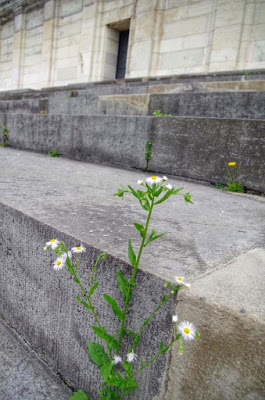The Kongresshalle and Zeppelinfeld have been under monument protection since 1973. The Zeppelinfeld was designed by Hitler's architect Albert Speer, and the Congress Hall was designed by Ludwig and Franz Ruff. Nowadays the whole site is a memorial, and parts are used as the Norisring motor racing track.

The building reached a height of 39 m (a height of 70 m was planned) and a diameter of 250 m. The design is inspired by the Coliseum in Rome. The foundation stone was laid in 1935, but the building remained unfinished and without a roof. The building with an outline of an "U" ends with two head-buildings. Since 2001, the Dokumentationszentrum Reichsparteitagselande (Documentation Centre Nazi Party Rally Grounds) has been located in the Northern wing. In the Southern wind is the Nuremberg Symphony Orchestra.
We visited after looking around the Documentation Centre Museum. There wasn't an awful lot to see but sheer size of the place and its resemblance to the Coliseum was impressive.
The Zeppelinfeld is located east of the Great Road. This was our next destination. It consists of a large grandstand 360 metres wide and a smaller stand. It was one of Albert Speer's first works for the Nazi party. It was constructed between 1934 and 1938. Up to 200,000 people could attend the site.
The grandstand is famous as being the building that had the swastika blown from the top in 1945, after Germany's fall in World War II. The name "Zeppelinfeld" or "Zeppelinwiese" comes from the event in August 1909 when Ferdinand Graf von Zeppelin landed with one of his airships (LZ6) in this location.
From 1947 to 1995 the Nurnberg American High School used the field for high school football and American football practice. In the 1970s, the pillars were removed for safety reasons as years of neglect had damaged the structure. The rest of the stand is intact and used as the centerpiece of the Norisring motor racing track. The German leg of the traveling heavy metal festival Monsters of Rock was held here twice during the 1980s. Another part of the grounds is home to a campground.
We visited on a hot and humid August afternoon, after visiting the Congresshalle. There were one or two people around but it was pretty quite and peaceful, in stark contrast to its rally days. I will let the photos tell the rest of the story . . .










































No comments:
Post a Comment